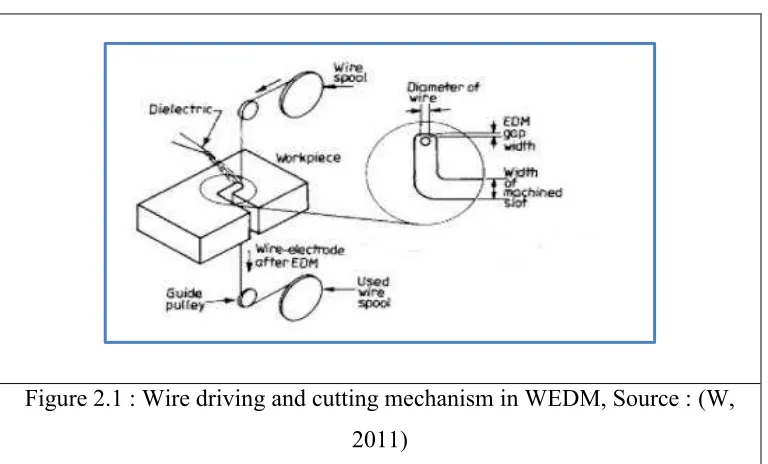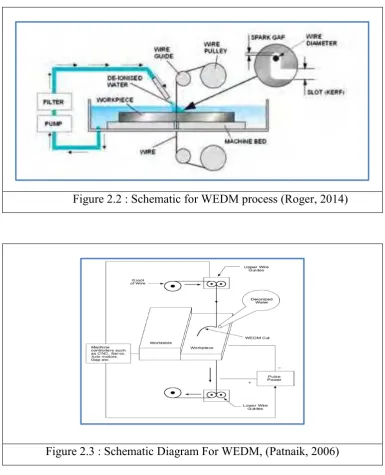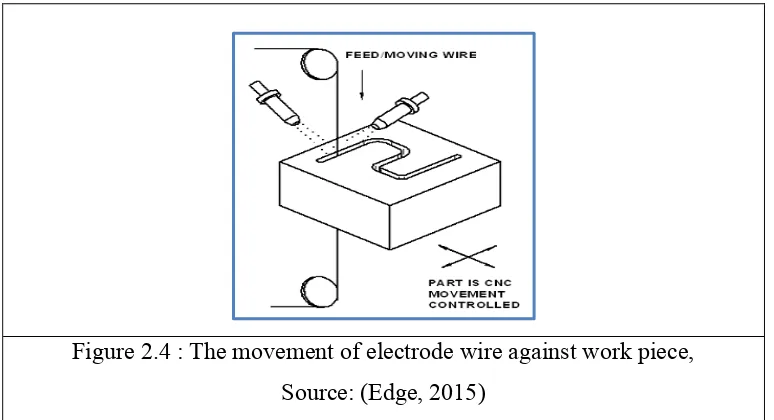UNIVERSITI TEKNIKAL MALAYSIA MELAKA
PROCESS OPTIMIZATION OF EDM CUTTING PROCESS ON
TOOL STEEL USING ZINC COATED ELECTRODE WIRE
This report submitted in accordance with requirement of the Universiti Teknikal Malaysia Melaka (UTeM) for the Bachelor of Manufacturing Engineering Technology
(Process & Technology) with Honours
By
MUHAMMAD QAMARUDDIN BIN MOHD AHYAN B071210458
910814-01-6793
UNIVERSITI TEKNIKAL MALAYSIA MELAKA
BORANG PENGESAHAN STATUS LAPORAN PROJEK SARJANA MUDA
TAJUK: PROCESS OPTIMIZATION OF EDM CUTTING PROCESS ON TOOL STEEL USING ZINC COATED ELECTRODE WIRE
SESI PENGAJIAN: 2015/16 Semester 1
Saya MUHAMMAD QAMARUDDIN BIN MOHD AHYAN
mengaku membenarkan Laporan PSM ini disimpan di Perpustakaan Universiti Teknikal Malaysia Melaka (UTeM) dengan syarat-syarat kegunaan seperti berikut:
1. Laporan PSM adalah hak milik Universiti Teknikal Malaysia Melaka dan penulis. 2. Perpustakaan Universiti Teknikal Malaysia Melaka dibenarkan membuat salinan
untuk tujuan pengajian sahaja dengan izin penulis.
3. Perpustakaan dibenarkan membuat salinan laporan PSM ini sebagai bahan pertukaran antara institusi pengajian tinggi. atau kepentingan Malaysia sebagaimana yang termaktub dalam AKTA RAHSIA RASMI 1972)
(Mengandungi maklumat TERHAD yang telah ditentukan oleh organisasi/badan di mana penyelidikan dijalankan)
(TANDATANGAN PENULIS)
3
PENGKELASAN LAPORAN PSM SEBAGAI SULIT/TERHAD LAPORAN PROJEK SARJANA MUDA TEKNOLOGI KEJURUTERAAN PEMBUATAN (Process & Technology): MUHAMMAD QAMARUDDIN BIN MOHD AHYAN
Sukacita dimaklumkan bahawa Laporan PSM yang tersebut di atas bertajuk
“Process Optimization Of Edm Cutting Process On Tool Steel Using
Zinc Coated Electrode Wire” mohon dikelaskan sebagai *SULIT / TERHAD
untuk tempoh LIMA (5) tahun dari tarikh surat ini.
2. Hal ini adalah kerana IANYA MERUPAKAN PROJEK YANG DITAJA OLEH SYARIKAT LUAR DAN HASIL KAJIANNYA ADALAH SULIT.
Sekian dimaklumkan. Terima kasih.
Yang benar,
________________
i
DECLARATION
I hereby, declared this report entitled “Process Optimization Of EDM Cutting Process On Tool Steel Using Zinc Coated Electrode Wire” is the results of my own
research except as cited in references.
Signature : ……….
Name : Muhammad Qamaruddin Bin Mohd Ahyan
ii
APPROVAL
This report is submitted to the Faculty of Engineering Technology of UTeM as a partial fulfillment of the requirements for the degree of Bachelor of Engineering Technology (BETP) (Hons.). The member of the supervisory is as follow:
iii
ABSTRACT
iv
ABSTRAK
v
DEDICATION
vi
ACKNOWLEDGEMENT
By the name of ALLAH, the Most Gracious and Most Merciful
Due to completion of this thesis, I am deeply indebted to my respected supervisor, Engr. Hanizam bin Hashim from Faculty of Engineering Technology, University Teknikal Malaysia Melaka (UTeM) for his encouragement, motivation, constructive criticism and beneficial guidance which led me through this project. I would also like to express my greatest gratitude to Mr. Mohd Kamal bin Musa from Faculty of Engineering Technology, co-supervisor of this project for his advice and continuously guides me during performing the Wire Electric Discharge Machine (WEDM). Special thanks to management of UTeM for the financial support throughout this project.
vii
1.4 Scope of the Research 3
1.5 Outline Of the Report 4
CHAPTER 2 5
LITERATURE VIEW 5
viii
2.1.1 Working Principles Of WEDM 7
2.2 Wire Electrode 9
2.2.1 Zinc Coated Brass Wire Electrode 9
2.3.1 Brass Wire Electrode 10
2.3 Tool (Electrode) 11
2.4 Influence Of Process Parameters On The Wire EDM Process 12
2.5 Surface Integrity 13
3.1 Project Planning (Flow Chart) 17
3.2 Material Selection 19
3.2.1 AISI H13 Material 19
3.3 Wire Electrodes 20
3.3.1 Zinc Coated Brass 20
3.3.2 Brass 21
3.4 Wire Electrical Discharge Machining 22
3.4.1 Parameter 24
3.5 Surface Roughness Tester Mitutoyo SJ-410 25
3.5.1 Standard Procedure for Surface Roughness Testing 26
3.6 Part To Be Cut 28
3.7 Data Collection 29
3.8 Wire-cut Electrical Discharge Machining (WEDM) Procedure 30
ix
RESULTS & DISCUSSION 31
4.1 Comparison Between Brass And Zinc Coated Electrode Wire 31
4.2 Comparison Between Different Diameter Of Zinc Coated Eletrode Wire 35
4.3 The Effects Of Feed Rate To Surface Roughness Data Collection 38
4.3.1 Analysis For 0.7 Against 1.1 41
4.3.2 Analysis For 0.9 Against 1.1 42
4.3.3 Analysis For 0.7 Against 0.9 43
CHAPTER 5 44
CONCLUSION & FUTURE WORK 44
5.1 Summary Of Research 44
5.2 Future Work 45
APPENDICES 47
APPENDIX A 48
EQUIPMENTS 48
APPENDIX B 50
WORK PIECE 50
x
LIST THE FIGURES
Figure 2.1 : Wire Driving And Cutting Mechanism In Wedm 6
Figure 2.2 : Schematic For WEDM Process 7
Figure 2.3 : Schematic Diagram For WEDM 7
Figure 2.4 : The Movement Of Electrode Wire Against Work Piece 8
Figure 2.5 : Pure Zinc Coating On Brass Wire Core 10
Figure 2.6 : Plain Brass 11
Figure 2.7 : Factors Influencing The Wire Edm Process 12 Figure 2.8 : Schematic Of The Work Piece And The Process 14
Figure 2.9 : Details Of Kerf Width 14
Figure 3.1 : Research Development Process Flow 18
Figure 3.2 : Mild Steel Plates 20
Figure 3.3 : Zinc Coated Brass Electrode Wire 21
Figure 3.4 : Brass electrode wire 22
Figure 3.5 : Wire Electrical Discharge Machining (Wedm) Sodick Vz300l 24
Figure 3.6 : Mitutoyo Surface Roughness Tester 25
Figure 3.7 : Illustration of application of Surface Roughness Tester 26
Figure 3.8 : Drawing path to be cut 28
Figure 4.1 : Brass Against Zinc Coated 33
Figure 4.2 : Interval Plot For Diameter Wire 37
xi
LIST OF TABLES
Table 3.1 : Physical Properties Of Tool Steel 19
Table 3.2 : Specification Of Zinc Coated Brass 21
Table 3.3 : Specification of Brass Electrode 22
Table 3.4 : Specification of Sodick VZ300L WEDM 23
Table 3.5 : Parameter during machining process 24
Table 3.6 : Specification Of Surface Roughness Tester 25 Table 3.7 : Procedure of using Mitutoyo Surface Roughness Tester 27
Table 3.8 : Table Of Experiment 29
Table 3.9 : Step By Step Of WEDM Operation Setup 30
Table 4.1 : Surface Roughness For Both Of The Wire 32
Table 4.2 : Minitab Result For Two-Sample T 34
xii
LIST ABBREVIATIONS, SYMBOLS
ANOM = Analysis Of Means
CNC = Computer Numerical Control EDM = Electrical Discharge Machine
H0 = Null Hypothesis
MRR = Material Removal Rate
Nc = Numerical Control
Ra = Surface Roughness
1
CHAPTER 1
INTRODUCTION
This chapter basically explains the background, problem statement, objectives and scope on research.
1.1 Project Background
Electrical Discharge Machining (EDM) is a process of metal machining in which a tool discharges thousands of sparks to a metal work piece. A non-conventional process, EDM melts or vaporizes cutting material, leaving little debris and providing a very accurate line. Industry-wide acceptance has led to a wide variety of EDM applications, as it is highly versatile, can cut hard metals, and utilizes a relatively compact amount of workspace.
2
its superior electrical conductivity, purity and structural integrity. However, due to the cost, Silver is rare to be used. (Kern, 2008)
Based on this project title, the main electrode material is zinc coated wire. It is consists of brass wire electroplated with high purity zinc. The high plating accuracy realizes faster machining speed and also provides a better surface finish on the work piece. The high purity zinc layer formed on the surface of the brass by means of our unique electroplating technology realizes higher machining speed.
By uniformly coating the surface of the wire with zinc, which has good discharge characteristics, it is possible to create a finer discharge compared to when using general brass wire. In the finishing process, improved surface roughness and a better machined profile are obtained, resulting in high cost performance. Almost no copper adheres to the work piece. The zinc coating method is a method of coating by electroplating. It is not a method in which is wire is dipped in molten zinc. A high purity uniform zinc layer can be obtained. The discharge is stable and free of irregularities. Impurities are kept to the minimum, thus preventing deterioration of performance. (Cable, 2012)
3 1.2 Problem Statement
Lately, Brass wire electrode been used in the industry for quite sometimes because its offer low cost and good quality finishing. in recent years, zinc coated brass offer higher cutting speed and performance. (Mms, 2015) However, study in this matter is still insufficient to prove zinc coated brass is better than brass.
1.3 Objective
Based on this problem, the type of wire to be testing is zinc coated brass electrode wire. In addition, this is the objective below:
1. To compare surface roughness of tool steel material using zinc coated brass and brass electrode wires.
2. To recommend the best electrode diameter to machine tool steel work piece material application.
3. To study the effects of feed rate to surface roughness.
1.4 Scope of the Research
4 1.5 Outline Of the Report
This project has been divided into five chapters covering the whole our culture in order to achieve the desired objectives. The contents of each chapter have been decided after the information was found. The included content is based on discussions with the supervisor and the information obtained from previous research.
Chapter 1 explains about the project background. Then it followed by objectives of the project, problem statements and scope of the project. Finally, in this chapter explain the outline of the project.
Chapter 2 shows the literature review about the previous work on the wire cut EDM machine. These previous study works as a guidance to perform or build the idea to solve the problems later.
Chapter 3 explains the methodology used in order to solve the problem. Methodology is important because the working progress followed the methodology step and makes it achieve the objective or not.
Chapter 4 explains procedures, results and discussion made after completion of the work done in the lab. All prove of the action that be done need to state in this chapter and attached with the explanation of the action.
5
CHAPTER 2
LITERATURE VIEW
This chapter basically explains about machinery and equipment used in this project as a guide for studies. Besides, basic information about Wire Electrical Discharge Machining (WEDM) will be tell and how to operate the machine. At early stage of the studies, some gap analysis has been carried out in order to ensure the relevance of this research. All relevant aspect such as current, speed travelling and diameter of electrode wire will be told a little bit in this chapter.`
2.1 Wire Electrical Discharge Machining (WEDM)
The introduction of continuous Wire-EDM to industrial practice in 1969 revolutionised the manufacture of punching, pressing and extrusion tools, and rapidly led to its achieving a monopoly. The process has also gained acceptance in prototype production and in series production e.g. for the aerospace industry. In the Wire-EDM process, the material is removed by means of temporally and spatially discrete discharges which produce local vaporization and melting in association with ejection processes. This enables all electrically-conductive materials to be processed without significant exertion of force, irrespective of their hardness.
6
geometry from the solid material as rapidly as possible, with an allowance for the secondary cuts. Accuracy and surface quality are still unsatisfactory after the main cut. The discharge energy is then gradually reduced during a series of 1-7 secondary cuts, to obtain high accuracy and good surfaces quality.
A volume of work piece has been removed during this short period of spark discharge depends on the desired cutting speed and the surface finish required. Estimated at around 15000 to 21000 Fahrenheit to heat of each electrical spark and erode away a bit of material that is vaporized and melted from the work piece. The chips are flushed away from the cut with a stream of deionised water through the top and bottom flushing nozzles. The heat build-up in the work piece is prevented by deionised water. (Moulton, 2015). Without this cooling system, thermal expansion of the work piece would affect size and positioning accuracy.
7
Figure 2.2 : Schematic for WEDM process (Roger, 2014)
Figure 2.3 : Schematic Diagram For WEDM, (Patnaik, 2006)
2.1.1 Working Principles Of WEDM
8
brass or tungsten that have diameter 0.05 mm until 0.3 mm which is capable of achieving very small radius of corner. By using mechanical tensioning device, the wire is kept in tension and can reduce to produce inaccurate parts. (Sathiaraj, 2015).
In WEDM, the conductive materials are machined with electrical discharging that will produce sparks between an accurately positioned of electrode wire and the work piece. According to (Cable, 2012), the high frequency pulses of alternating or direct current is discharged from the electrode wire with a small gap or spark through a dielectric fluid. Sparks can be observed and the actual discharging occur more than one hundred thousand times per second and lasting in the range of 1/1000000 of a second or less.
A volume of work piece has been removed during this short period of spark discharge depends on the desired cutting speed and the surface finish required. Estimated at around 15000 to 21000 Fahrenheit to heat of each electrical spark and erode away a bit of material that is vaporized and melted from the work piece. (Moulton, 2015). The chips are flushed away from the cut with a stream of deionised water through the top and bottom flushing nozzles. The heat build-up in the work piece is prevented by deionised water. (Edge, 2015). Without this cooling system, thermal expansion of the work piece would affect size and positioning accuracy.
9 2.2 Wire Electrode
A variation of EDM is WEDM or electrical discharge wire cutting. In WEDM process, this almost similar to contour cutting with a band saw. The wire travels slowly along a prescribed path and the work piece is cutting with discharge sparks. The wire can cut a work piece as thick as 300 mm and usually being used to make a mould, punches, tool and dies from hard metal. Intricate components for the electronics industries also will be cut. According to (Wukesha, 2014) accessed on 5 May 2014, WEDM is a machine to cut material with a slight wire anode that takes after a customized way. The wires are generally made of metal, copper or tungsten. Zinc or metal covered wires are additionally being utilized. The wire diameter is typically about 0.30 mm for roughing cut and 0.20 mm for finishing cut.
There is no effect on cutting speed even the work piece material is hardness and no physical contact between the wire and part being machined. The important factors in selecting brass and copper are ability to generate an electric discharge, mechanical strength at high temperature, high electrical conductivity and high heat conductivity. The wire also should have sufficient tensile strength and fracture toughness as well as high electrical conductivity and capacity to flush away the debris produces during the cutting. (Wukesha, 2014)
2.2.1 Zinc Coated Brass Wire Electrode


